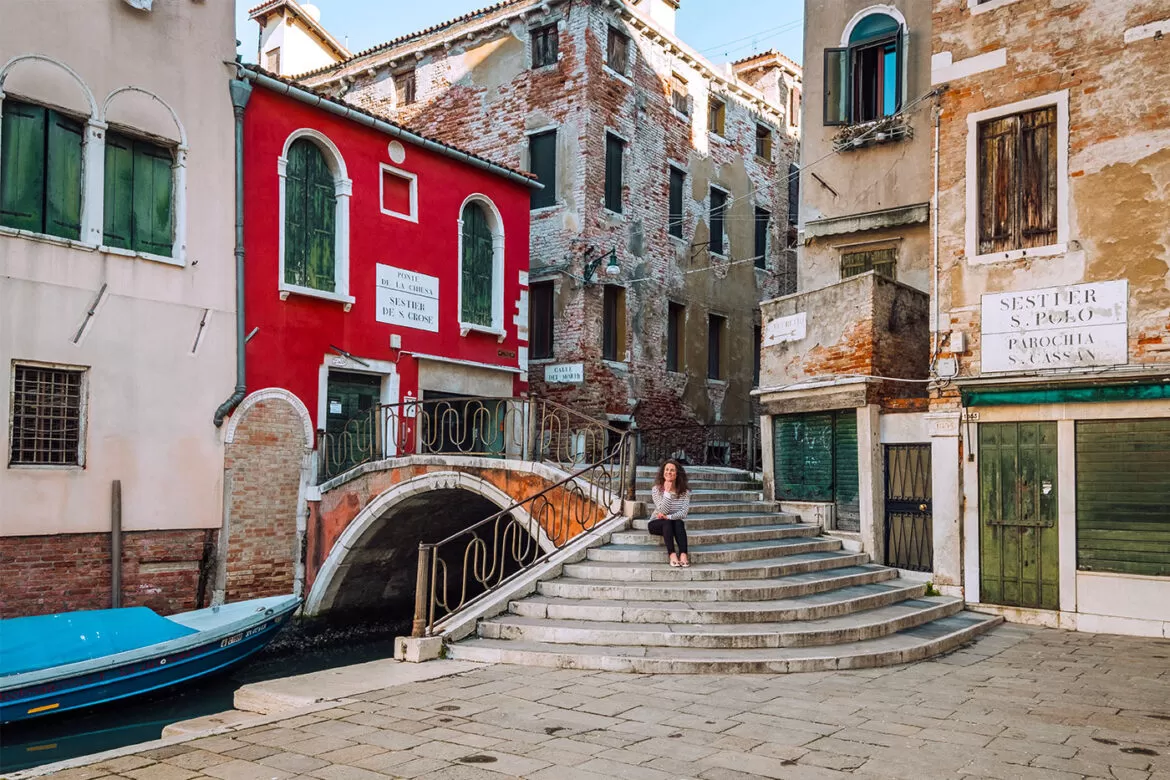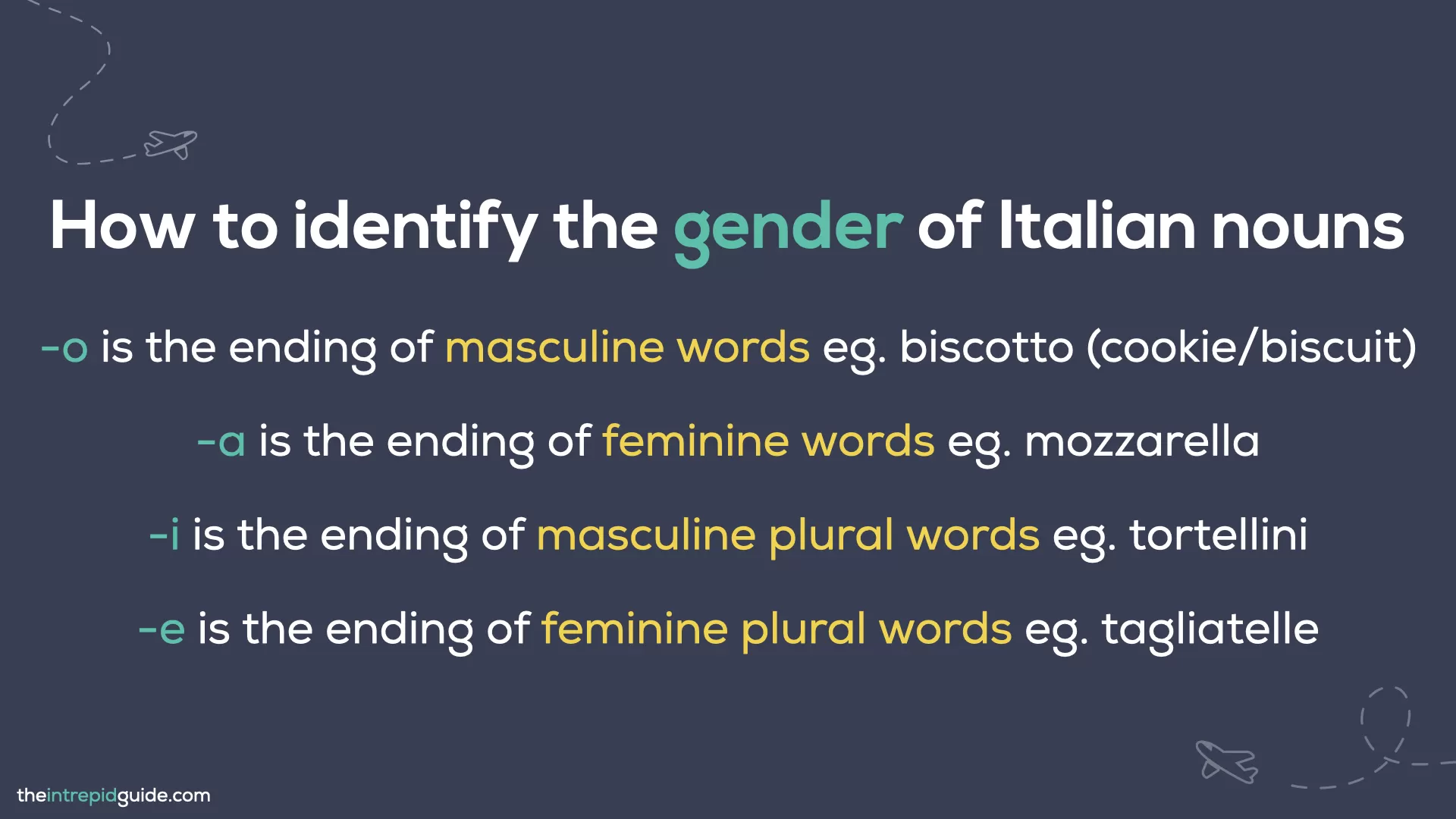You already know many Italian words, many food-related: including pizza, carbonara, risotto, spaghetti, lasagne, and gnocchi! What you may not know is that Italian words like these are gendered; this means that they can be either feminine or masculine. This is called grammatical gender. So, how do you know if a word is feminine or masculine in Italian? And why are Italian words feminine or masculine?
In this guide, we’ll look at what grammatical gender is, how to find out the gender of a word in Italian, and how to use Italian definite and indefinite articles.
Pronti? (Ready?) Cominciamo! Let’s get started!
Why is grammatical gender important?
If you’re new to language learning, you may have never heard of grammatical gender. When we talk about gender in terms of language learning, it means that a word can be either masculine, feminine, or neuter. In Italian, all nouns, articles, pronouns and adjectives have a gender maschile (masculine) and femminile (feminine). To help you brush up on these basic grammatical terms, here is a quick recap:
Nouns – Generally speaking, this is anything you can place a/an or the in front of. This could be a place, idea, animal, thing, event, or person. For example, a bowl of pasta or the Colosseum.
Definite/indefinite articles – this is a word placed before a noun to indicate whether we are talking about a specific thing or in general. In English, we use the when speaking about a specific thing. For example, the house. This is called a definite article. When we speak about something in general, we use a. For example, a house. This is called an indefinite article.
Pronouns – A pronoun is a word that replaces a noun in a sentence. In English, we use I, you, he/she/it, we, you (plural), they. For example, in the sentence ‘Mario ate a pizza’ we can replace Mario’s name with He to say ‘He ate a pizza’.
Adjectives – Anything that you can place is in front of is an adjective. An adjective describes something. For example, is small, is round, is smart, is hot.
Gender in Italian
In Italian, all nouns have a specific gender (masculine and feminine) and number (singular and plural). It’s important to note that you shouldn’t confuse these grammatical terms with the biological terms ‘male’ and ‘female’.
Once upon a time, English also used grammatical gender. In fact, there are still some leftovers. Have you ever noticed that we spell blonde with an e, when referring to a female and blond when referring to a male? What about how we instinctively refer to cars and ships as her, or she. This isn’t logical, it’s custom. Remember this when learning Italian words.
Italian articles
Just like in English, there are two main types of articles in Italian: definite, and indefinite.
- The definite article is used to introduce nouns that refer to a specific item. In English, we would use the article the.
- The indefinite article is used when we know what type of person or thing the noun refers to, but not which individual; they are equivalent to the articles a and an in English. The indefinite article has no plural.
How to identify the gender of a noun in Italian
The reason why any given noun is feminine or masculine is not always clear. Identifying the gender of Italian nouns is fairly simple and easy. The clue is in the endings! Most Italian nouns end in a vowel. If a noun ends with a consonant, it’s of foreign origin.
The endings or nouns are almost always consistent, whether they are masculine or feminine. There are exceptions, of course. Now, let’s look at some of the words (or nouns) we saw earlier to discover their gender.
- Pizza is feminine. You can tell from the ending in -a . The same applies to ‘carbonara’
- Risotto is masculine. When we see the ending -o, this usually lets us know the word is masculine.
- Spaghetti is also masculine, but the letter -i defines a masculine word in the plural form. Tip: the word ‘spaghetto’ doesn’t exist, but I challenge you to have a dish with just one spaghetto! Not enough, to be sure!
- Lasagne is feminine plural. We know this because it ends with an -e.
These endings of Italian words are quite important to remember. So let’s summarize these rules again. We have:
- o is the ending of masculine words eg. biscotto (cookie/biscuit)
- a is the ending of feminine words eg. mozzarella
- i is the ending of masculine plural words eg. tortellini
- e is the ending of feminine plural words eg. tagliatelle
There are, of course, some exceptions – we wouldn’t be Italians without exceptions! – but the rule applies to most cases.
The Singular Definite Article in Italian
Gender also affects the kind of article we need to put before a noun.
Italian has its fair share of articles but, of course, articles have to match the gender and number of the word they relate to. Sounds difficult? No! It’s just a question of practice – the more you read or listen to Italians speaking, the more familiar articles will become!
Let’s look at each article one by one.
First of all, the definite articles – what in English we identify with as the.
- The risotto – il risotto → il is the masculine article with words starting with most consonants
- The pizza – la pizza → la is the feminine article with words starting with any consonant
There are a few more definite articles to consider:
- We use lo with masculine words starting with gn, s + consonant, pn, ps, x, y and z.
For example, we say lo sport, lo yogurt, and lo zio (the uncle). - We use l’ with masculine and feminine words starting with a vowel (a, e, i, o, u).
For example, l’autostrada (highway), l’amico (the male friend)
The Plural Definite Article in Italian
Now, let’s take a look at nouns in the plural form such as… spaghetti, tagliatelle, lasagne, but also bambini (children), nonni (grandparents) and fratelli (brothers).
La famiglia has to be reckoned with, especially if you have an Italian background!
Let’s take a look at plural definite articles:
- le is used before feminine words in the plural starting with consonants or vowels
eg. le lasagne, le nonne (grandmothers), etc. - i is used before masculine words starting with most consonants.
eg. i nonni (the grandparents), i fratelli (brothers/siblings) - gli is used before masculine words starting with vowels, gn, s + consonant, pn, ps, x, y and z.
eg. gli spaghetti, gli zii (uncles)
Summary of Italian definite articles
We’ve covered a lot of ground so far. So, let’s take a look at the five rules for using definite articles:
Rule #1
Lo (plural gli) is used before masculine nouns that begin with gn, s + consonant, pn, ps, x, y and z.
Example: lo specchio (the mirror), gli specchi (the mirrors)
Rule #2
Il (plural i) is used before masculine nouns that begin with all other consonants.
Example: il biglietto (the ticket), i biglietti (the tickets)
Rule #3
La (plural le) is used before feminine nouns that begin with a consonant.
Example: la macchina (the car), le macchine (the cars)
Rule #4
L’ (plural gli) is used before masculine nouns that begin with a vowel.
Example: l’amico (the male friend), gli amici (the friends)
Rule #5
L’ (plural le) is used before feminine nouns that begin with a vowel.
Example: l’ambulanza (the ambulance), le ambulanze (the ambulances)
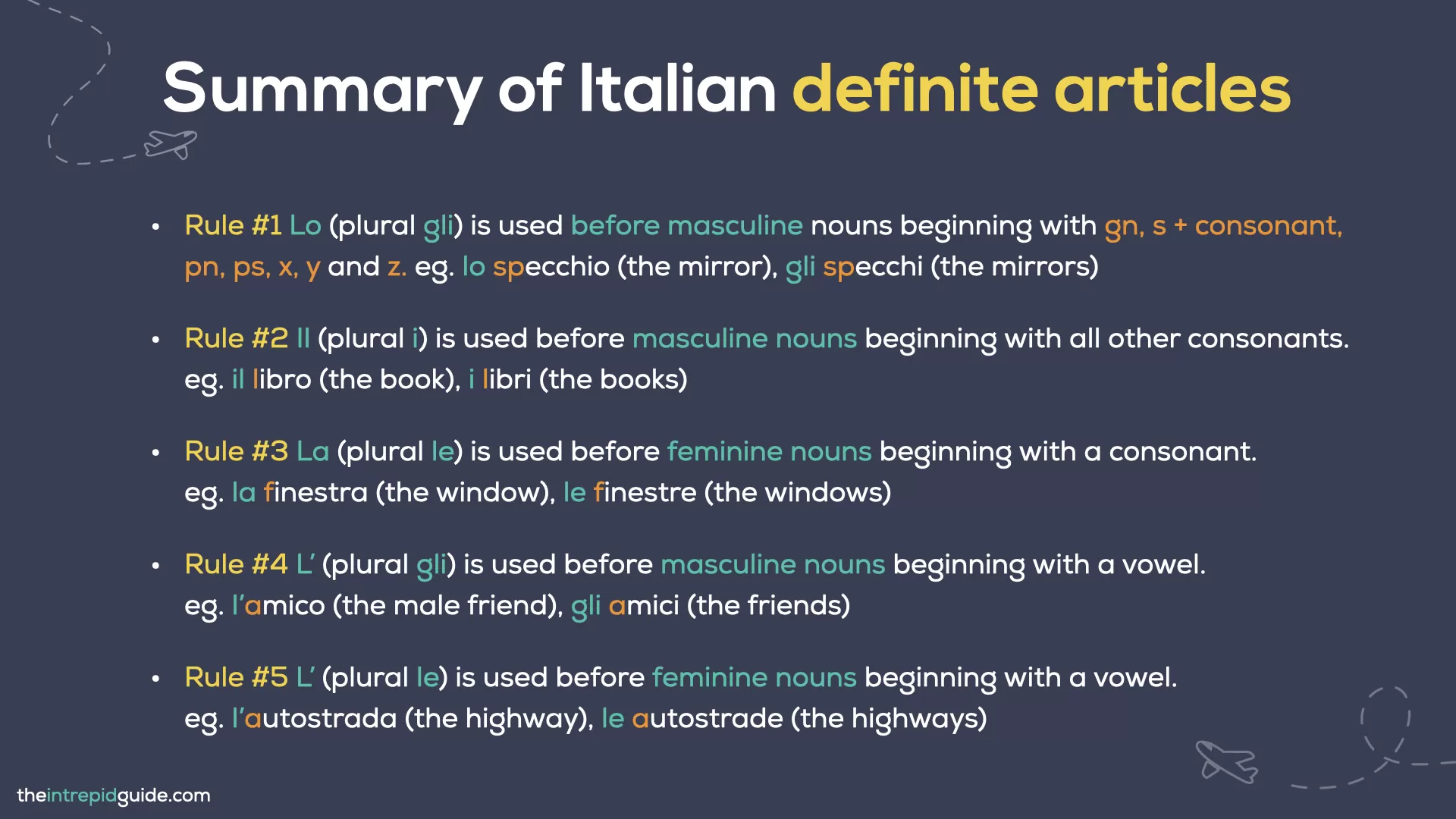 Or put another way, here is a table of all possible definite articles.
Or put another way, here is a table of all possible definite articles.
| Gender of Italian nouns | Singular | Plural | Examples |
|---|---|---|---|
| Masculine | il | i | il treno (train) il tavolo (table) il panino (sandwich) |
| – begins with a vowel | l’ | gli | l’estratto (extract) l’ambasciatore (ambassador) |
| – begins with gn, s + consonant, pn, ps, x, y and z | lo | gli | lo gnomo (the gnome), lo studente (the student) lo pneumatico (the tyre), lo psicologo (the psychologist), lo yogurt (the yoghurt), lo zaino (the backpack), lo zio (the uncle) |
| Feminine | la | le | la mamma, la pizza |
| – begins with a vowel | l’ | le | l’area, l’internet, l’unione, l’idea |
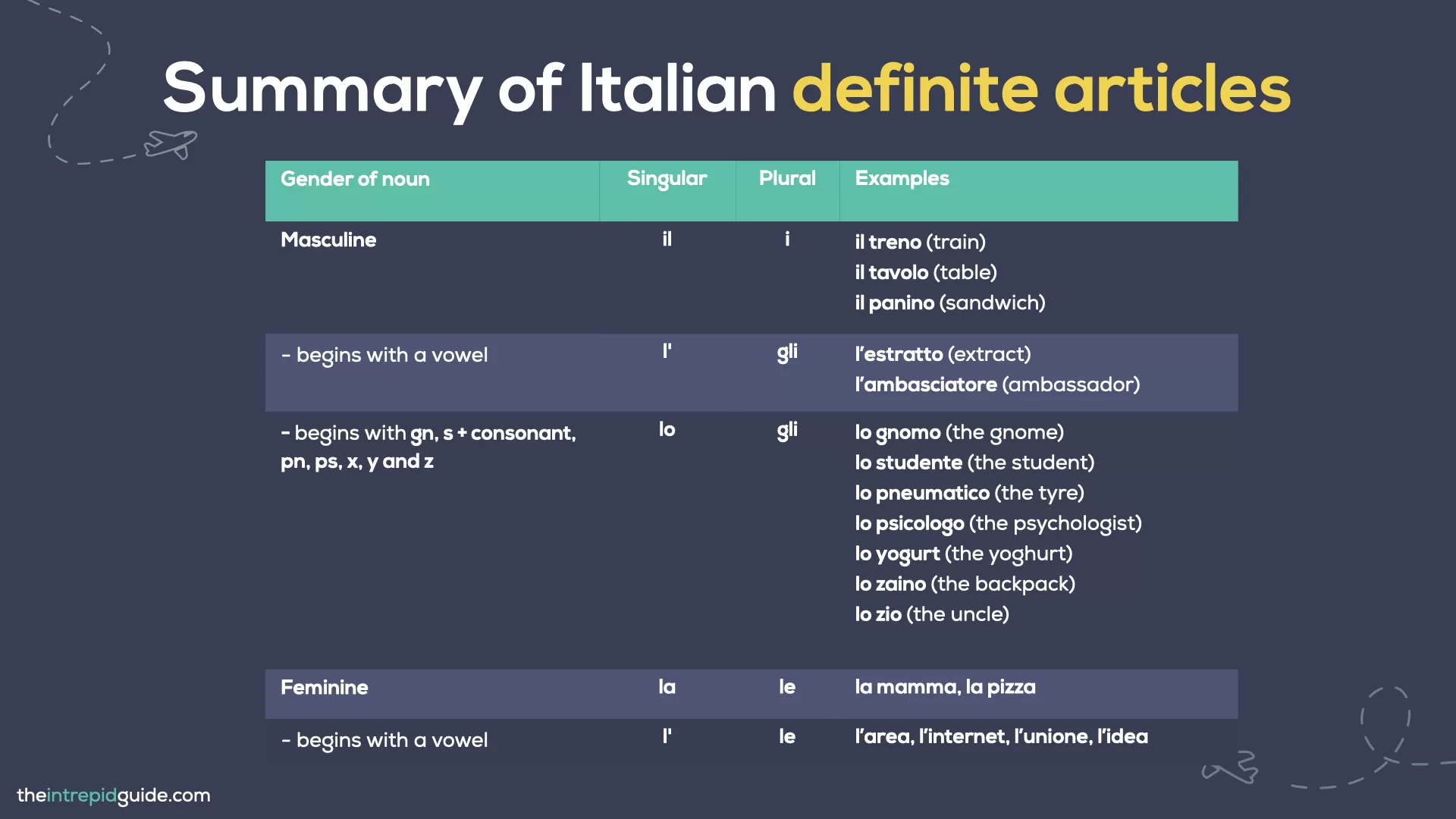 The Italian Indefinite Article
The Italian Indefinite Article
We know all the ways to say ‘the’, in Italian. So, how do we translate ‘a’ and ‘an’ in Italian? We have four options: un, uno, una, un’. Does a certain card game spring to mind? Like UNO!? This can be a great memory hook to help you remember that UNO means one, or a/an.
Look at these words. Can you guess which articles match each word? Let’s try!…..
- panino (sandwich) → masculine singular … What is it? un panino!
- ….. mamma (mum) → feminine singular … What is it? una mamma! Bravo!
When do we use uno? Can you guess? Think back to the definite masculine article where we used lo, this is its indefinite form, uno. Let the final -o in both of these articles help you to remember this rule. Again, uno is used before masculine words starting with the rebellious consonants gn, s + consonant, pn, ps, x, y and z.
- uno zio (an uncle)
- uno studente (a male student)
- uno psicologo (a male psychologist)
Last but not least, we have un’. This indefinite article is used before feminine words starting with a vowel. The apostrophe is there to avoid doubling up on vowels so it’s easier to pronounce and rolls off the tongue.
- un’amica (a female friend)
- un’acqua minerale (a mineral water)
Summary of Italian indefinite articles
Here are four rules to apply when using indefinite articles:
Rule #1
Uno is used before masculine words that begin with z or s + consonant, ps, or gn.
Example: uno zaino (a backpack)
Rule #2
Un is used before all other masculine words that begin with any other consonant or vowel.
Example: un aeroplano (an airplane)
Rule #3
Una is used before feminine words that begin with a consonant.
Example: una stazione (a station)
Rule #4
Un’ is used before feminine words that begin with a vowel.
Example: un’automobile (a car)
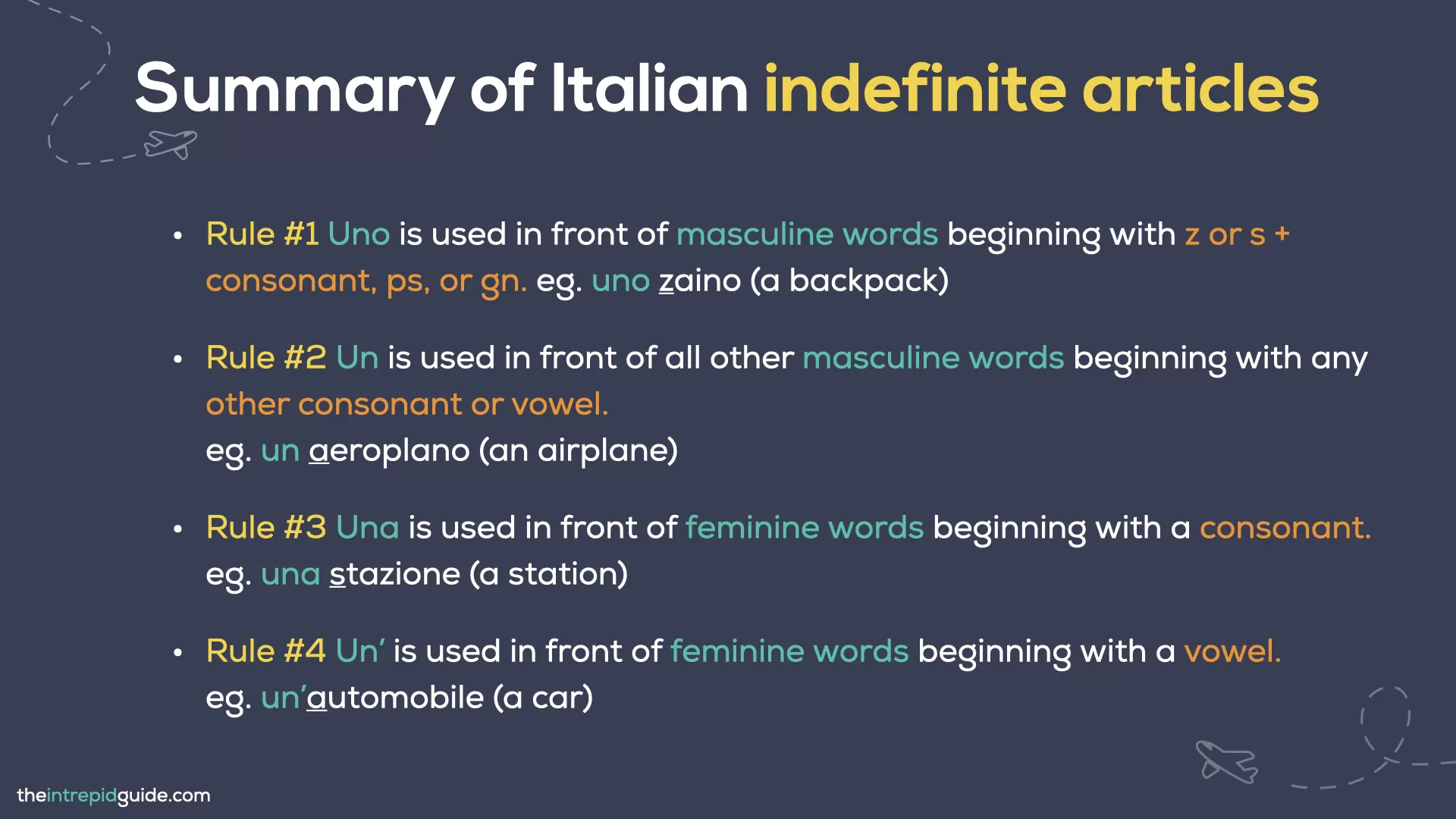 As you come across new words in Italian you’ll start to recognise and remember these rules instinctively.
As you come across new words in Italian you’ll start to recognise and remember these rules instinctively.
 Enjoyed this guide? Are you a beginner or an intermediate Italian learner? Got a trip coming up or want to communicate with your Italian partner or relatives in Italian? Learn Italian with my unique 80/20 method
Enjoyed this guide? Are you a beginner or an intermediate Italian learner? Got a trip coming up or want to communicate with your Italian partner or relatives in Italian? Learn Italian with my unique 80/20 method
Registrations are now open to join Intrepid Italian, my new series of online video courses that use my unique 80/20 method. You’ll go from a shy, confused beginner to a proficient and confident intermediate speaker, with me as your trusty guide.
You’ll finally be able to connect with your Italian partner, speak to your relatives and enjoy authentic travel experiences in Italy that you’ve always dreamed of, and so much more.
As a native English speaker who learned Italian as an adult, I know what it’s like to feel hopeless and lack the confidence to speak. I know what it’s like to start from scratch and to even go back to absolute basics and learn what a verb is!
Intrepid Italian was created with YOU in mind. I use my working knowledge of the English language to help you get into the ‘Italian mindset’ so you can avoid the common pitfalls and errors English speakers make – because I made them once too! I break everything down in such a way that it ‘clicks’ and just makes sense.
No matter what your level is, there is an Intrepid Italian course for you, including:
- 🇮🇹 Intrepid Italian for Beginners (A1)
- 🇮🇹 Intrepid Italian for Advanced Beginners (A2)
- 🇮🇹 Intrepid Italian for Intermediates (B1)
You can join 1, 2, or all 3 courses, it’s entirely up to you. The best part is that you have lifetime access so you learn anytime, anywhere and on any device.
As your guide, I walk you through each lesson, step-by-step, using my unique 80/20 method. My approach is different from traditional methods because I teach you the most important 20% of the language right from the beginning so you can start to speak straight away.
Each course includes video lessons, audio exercises, downloadable worksheets, bonus guides, a private support community, and lifetime access all designed to streamline your learning while having fun.
It even comes with my famous Celebrate with a Spritz Guarantee. After 30 days of using Intrepid Italian, if you don’t want to celebrate your newfound Italian skills with an Aperol Spritz, you don’t have to pay a penny! Cheers! 🥂
Join Intrepid Italian here and start learning today!
Ci vediamo lì! (See you there!)
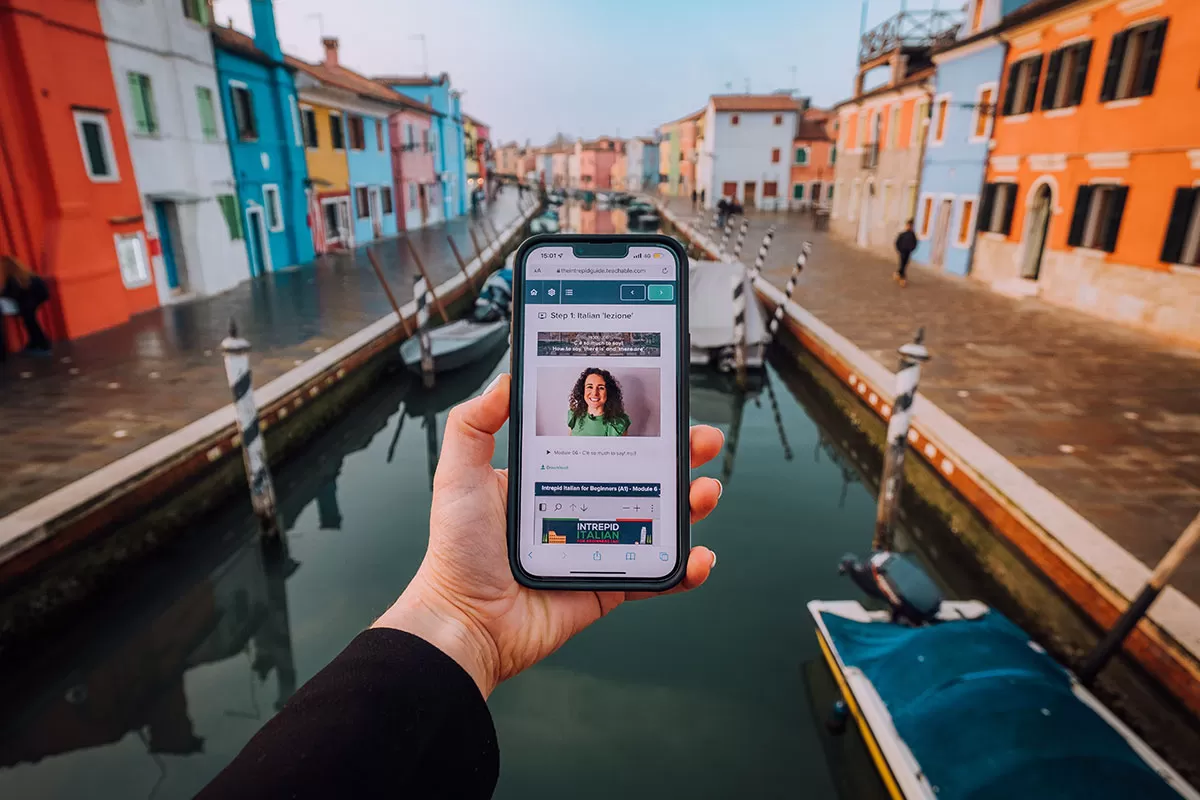
Learning Italian? Check out these Italian language guides
- Italian for Beginners | How to Learn Italian in 3 Simple Steps
- 170+ Countries & Nationalities in Italian: The Definitive Guide (Plus PDF Cheat-Sheet & Quiz)
- Italian Cognates & Loanwords: 17 Rules to Italianizing English Words You Already Know
- Ultimate Guide to the Italian Alphabet: Letters, Pronunciation, and Stress
- How to say ‘Merry Christmas’ in Italian [Plus New Year Vocabulary and Quiz]
- 34 Words That Don’t Exist in Italian (English Loanwords in Italian)
- Italian Culture: 19 Weird Things Italians Do That No One Warns You About
- 17 Weird Italian Superstitions Italians ACTUALLY Live By
- 17 Must-Know Italian Hand Gestures: The Ultimate Guide
- Top 24 Most Important Verbs in Italian (Plus PDF Cheat-Sheet & Quiz)
- 10 Ways Natives REALLY Say ‘You’re Welcome’ in Italian
- How to say ‘Please’ in Italian in 9 Ways Like a Native
- 41 Italian Greetings: How to Say ‘Hello’ in Italian Like a Local
- 125 Most Common Italian Phrases for Travel You’ll Ever Need [PLUS Printable]
- 8 DEADLY mistakes in Italian (& How to Avoid Them)
- How to Conjugate Italian Verbs in 3 Simple Steps [Italian for Beginners]
- Is Italian Hard to Learn? 7 Common Mistakes & How to Avoid Them
- Master Days of the Week in Italian (7 Simple Memory Hacks)
- Italian Numbers: How to Count in Italian From 0 to 1 Billion (Plus PDF Download)
- How to Order Food & Drinks in Italian [Italian for Beginners]
- 15 Italian Words You Should NEVER Mispronounce [& How Not To]
- 11 Effective Hacks That’ll Help You Learn Italian So Much Faster
- Top 14 Italian Words You Should NEVER Say [& What to Use Instead]
- 20 Hilarious Everyday Italian Expressions You Should Use
- Romanesco: 25 Cool Roman Dialect Words You Should Use in Rome
- 10 Reasons Why Learning Italian Will Change Your Life
- 10 Italian Expressions Italians Love Saying
- 10 Italian Phrases That Will Instantly Make You Sound more Italian
- Funny Italian Sayings: 26 Food-Related Insults You Won’t Forget
- 15 Romantic Italian Films That’ll Make You Love Italy Even More
- How to Master Common Italian Phrases for Travel (Like a Local!)
Like it? Pin it for later!
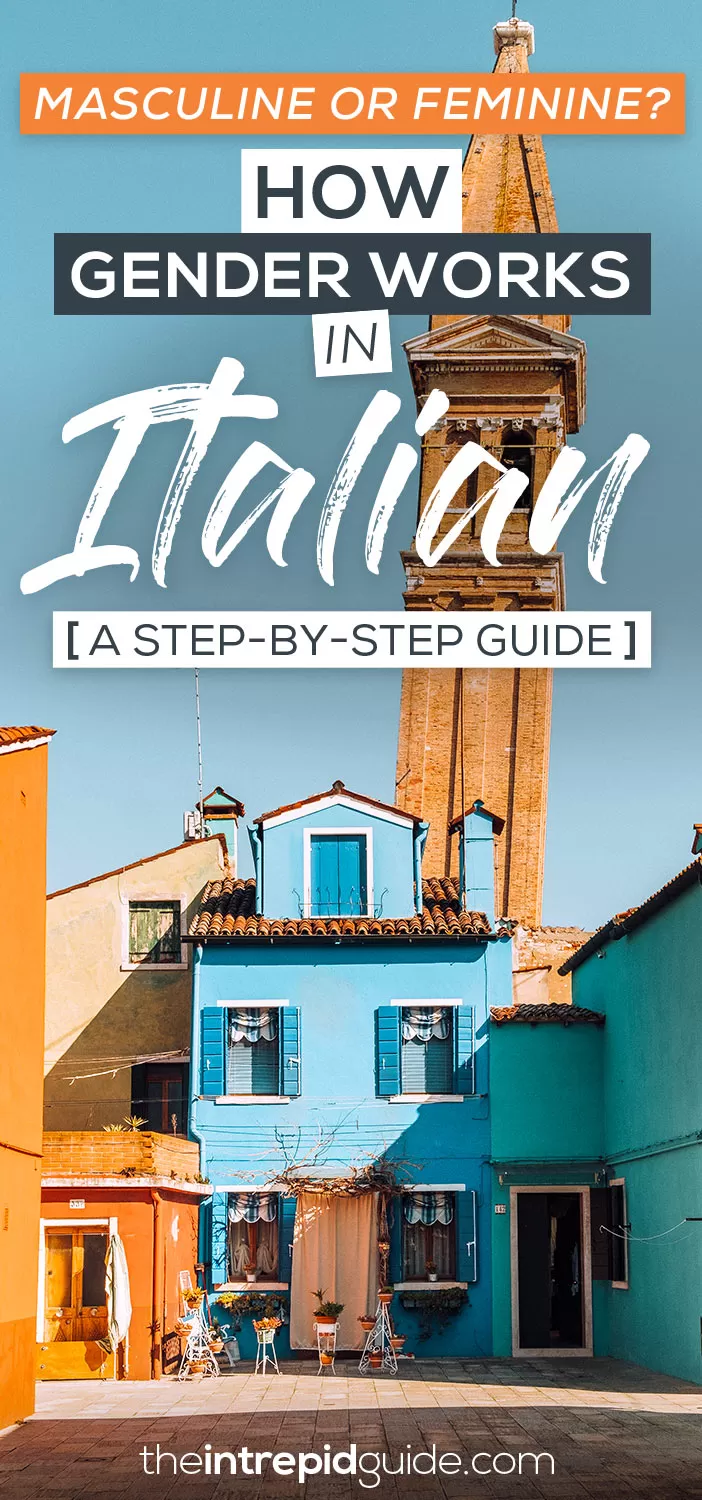
Over to you!
Did you find this guide helpful? Got a question? Let me know using the comments section below or join me on social media @intrepidguide or @intrepiditalian to start a conversation.
Thanks for reading and I hope you enjoyed this post.
Like what you see? Subscribe using the form below to have all of my posts delivered directly to your email.

